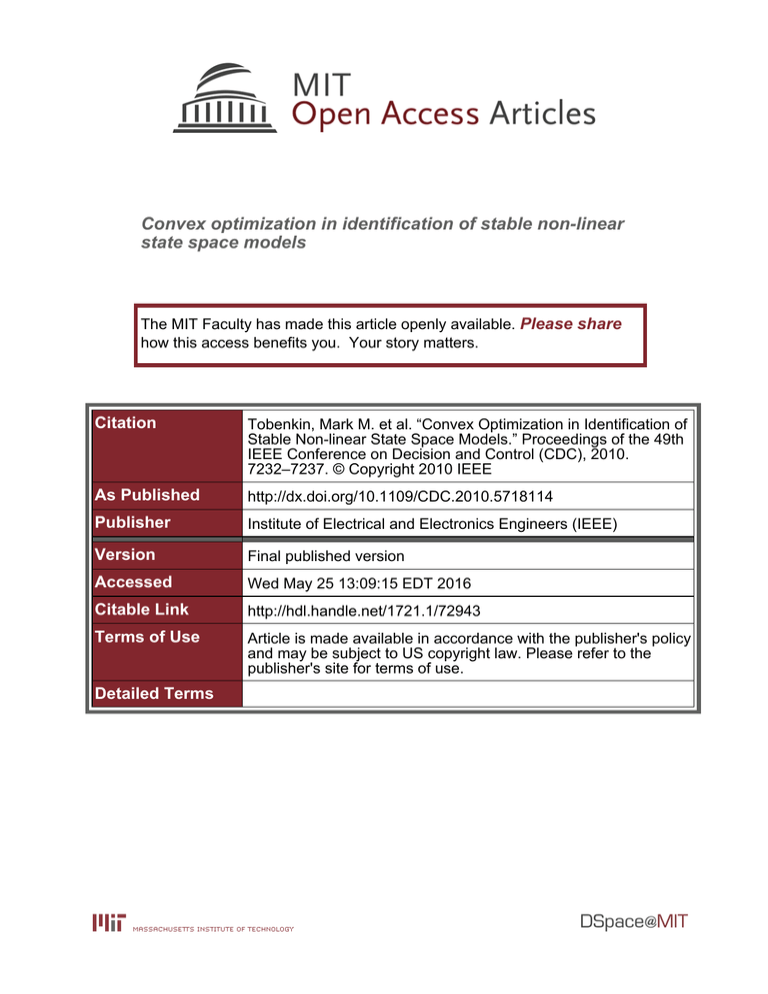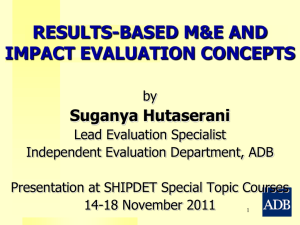Convex optimization in identification of stable non-linear state space models Please share
advertisement

Convex optimization in identification of stable non-linear
state space models
The MIT Faculty has made this article openly available. Please share
how this access benefits you. Your story matters.
Citation
Tobenkin, Mark M. et al. “Convex Optimization in Identification of
Stable Non-linear State Space Models.” Proceedings of the 49th
IEEE Conference on Decision and Control (CDC), 2010.
7232–7237. © Copyright 2010 IEEE
As Published
http://dx.doi.org/10.1109/CDC.2010.5718114
Publisher
Institute of Electrical and Electronics Engineers (IEEE)
Version
Final published version
Accessed
Wed May 25 13:09:15 EDT 2016
Citable Link
http://hdl.handle.net/1721.1/72943
Terms of Use
Article is made available in accordance with the publisher's policy
and may be subject to US copyright law. Please refer to the
publisher's site for terms of use.
Detailed Terms
49th IEEE Conference on Decision and Control
December 15-17, 2010
Hilton Atlanta Hotel, Atlanta, GA, USA
Convex Optimization In Identification Of
Stable Non-Linear State Space Models
Mark M. Tobenkin1 Ian R. Manchester1 Jennifer Wang2 Alexandre Megretski3 Russ Tedrake1
1: Computer Science and Artificial Intelligence Laboratory, Massachusetts Inst. of Tech.
2: Department of Brain and Cognitive Sciences, Massachusetts Inst. of Tech.
3: Laboratory for Information and Decision Systems, Massachusetts Inst. of Tech.
{mmt, irm, jenwang, ameg, russt}@mit.edu
Abstract— A new framework for nonlinear system identification is presented in terms of optimal fitting of stable
nonlinear state space equations to input/output/state data, with
a performance objective defined as a measure of robustness
of the simulation error with respect to equation errors. Basic
definitions and analytical results are presented. The utility of
the method is illustrated on a simple simulation example as
well as experimental recordings from a live neuron.
I. I NTRODUCTION
Converting numerical data, originating from either physical measurements or computer simulations, to compact
mathematical models is a common challenge in engineering.
The case of static system identification, where models y =
h(u) defined by “simple” functions h(·) are fitted to data
records of u and y, is a major topic of research in statistics
and machine learning. This paper is focused on a subset
of dynamic system identification tasks, where state space
models of the form
x(t + 1) = f (x(t), u(t)),
(1)
y(t) = g(x(t), u(t)),
(2)
where f and g are “simple” functions, are extracted from data
records of x̃, ỹ, and ũ. We will also consider continuous time
models of the form
ẋ(t) = f (x(t), u(t)),
(3)
with (2). If the data come from simulations of a complex
model rather than experiments then this task is referred to
as model reduction.
There are two common and straightforward approaches
to this problem: In equation-error minimization (see, e.g.,
[1], [2]) a model is sought
P which minimizes a cost function
2
of the following form:
t |x̃(t + 1) − f (x̃(t), ũ(t))| , or
similar, over the unknown parameters of f (·). A similar
optimization can be set up for g(·). This is typically very
cheap computationally, often reducing to basic least squares.
However, if there is no incremental stability requirement then
small equation errors do not imply small simulation errors
over extended time intervals. For large scale and nonlinear
problems it is not unusual to find unstable models by this
This was supported by National Science Foundation Grant No. 0835947.
978-1-4244-7746-3/10/$26.00 ©2010 IEEE
method, particularly if the true system is not in the model
class being searched over.
In Simulation-error minimization (see, e.g., [3])
Pone sets
up a nonlinear programming problem to find minη t |ỹ(t)−
yη (t)|2 where yη is the output of the simulation of the model
system with a particular set of parameters η which define
f (·) and g(·). If successful, this can give a more robust fit
than equation error. However, the relationship between the
unknown parameters η and the long-term simulation yη (t)
is highly nonlinear and the optimization nonconvex. For
black-box models with a large number of parameters, this
optimization can be very difficult.
The method proposed in this paper can be considered a
middle-ground between these two extremes: we formulate a
convex optimization problem to minimize an upper bound
on the true simulation error while guaranteeing the stability
and well-posedness of the identified model. Furthermore, we
show that that in some simple cases the upper bound is tight.
Other recent efforts on identification of guaranteed stable
models include LMI conditions for linear systems [4], convex
relaxations for linear [5] and Wiener-Hammerstein systems
[6], as well as passivity-like conditions for linear [7] and
nonlinear models [8].
We are freely providing a MATLAB implementation of
the proposed technique as part of SPOT [9].
II. P ROBLEM S ETUP
A. State Space Models
We examine discrete time (DT) state space models of the
form
e(x(t + 1)) = f (x(t), u(t)),
y(t) = g(x(t), u(t)),
n
n
n
m
n
(4)
(5)
n
where e : R 7→ R , f : R × R 7→ R , and g : R ×
Rm 7→ Rk are continuously differentiable functions such
that the equation e(z) = w has a unique solution z ∈ Rn for
every w ∈ Rn .
B. Stability
We consider the DT model (4),(5) stable if the difference
{y1 (t) − y0 (t)}∞
t=1 is square summable for every two solutions (u, x, y) = (u1 , x1 , y1 ) and (u, x, y) = (u0 , x0 , y0 ) of
7232
(4),(5) with the same input u1 = u0 = u. This definition can
be qualified as that of global incremental output ℓ2 -stability.
˜
where ∆(·)
is defined by
˜ + 1) = F (x̃(t), ũ(t))∆(t)
˜ + ǫx (z̃(t)), (15)
E(x̃(t + 1))∆(t
C. Data
In applications, we expect to have input/state/output information available in the form of sampled data Z̃ =
{z̃(ti )}N
i=1 , where z̃(ti ) = (ṽ(ti ), x̃(ti ), ũ(ti ), ỹ(ti )). Here
x̃, ũ, ỹ represent approximated samples of state, input, and
output respectively, and ṽ approximates the “next” state.
Section VI-A will discuss approaches for approximating the
state of the system from input-output data.
For the purpose of theoretical analysis, we will assume that
the input/state/output information is available in the form of
signal data where ṽ, x̃, ũ, and ỹ are signals, i.e. functions
x̃, ṽ : T 7→ Rn , ũ : T 7→ Rm , ỹ : T 7→ Rk
(6)
such that
T = {1, . . . , N },
ṽ(t − 1) = x̃(t) ∀ t ∈ {2, . . . , N }. (7)
˜
with initial condition ∆(1)
= 0, and E = E(x), F =
F (x, u) and G = G(x, u) defined to be the Jacobians (with
respect to x) of e, f and g respectively.
F. Optimization Setup
Within the framework of this paper, we consider efficient
global minimization of the simulation error Ē (over all model
functions e, f, g, defining a stable system) as an ultimate (if
perhaps unattainable) goal. We proceed by defining upper
bounds for Ē and Ē 0 which can be minimized efficiently by
means of convex optimization (semidefinite programming).
We will also prove some theoretical statements certifying
quality of these upper bounds.
D. Simulation Error
III. ROBUST I DENTIFICATION E RROR
Given DT signal data Z̃ and functions e, f, g, the simulation error associated with a model matching (4),(5) is defined
as
N
X
|ỹ(t) − y(t)|2 ,
(8)
Ē =
t=1
where y(t) is defined by (4),(5) with u(t) ≡ ũ(t) and x(1) =
x̃(1).
E. Linearized Simulation Error
A simplified version of the simulation error measure Ē is
the linearized simulation error Ē 0 defined in the following
way. Consider a “perturbed” version of the system equations
e(xθ (t + 1)) = f (xθ (t), u(t)) − f0 (t),
(9)
yθ (t) = g(xθ (t), u(t)) − g0 (t).
(10)
Here θ ∈ [0, 1], f0 (t) = (1 − θ)ǫx (z̃(t)), and g0 (t) =
(1 − θ)ǫy (z̃(t)), where ǫx and ǫy are the equation errors are
defined by:
ǫx (z̃) = f (x̃, ũ) − e(ṽ),
(11)
ǫy (z̃) = g(x̃, ũ) − ỹ.
(12)
We examine the solution (xθ , yθ ) of (9),(10) with xθ (1) =
x̃(1), u(t) ≡ ũ(t).
By construction, yθ = y for θ = 1, and yθ = ỹ for θ = 0.
We define
N
1 X
|ỹ(t) − yθ (t)|2
Ē (z̃(t)) = lim 2
θ→0 θ
t=1
0
Ē 0 =
t=1
A. Global RIE
The global RIE measure for a DT model (4),(5) is a
function of the coefficients of (4),(5), a single data sample
z̃ = (ṽ, x̃, ũ, ỹ) ∈ Rn × Rn × Rm × Rk ,
(13)
EQ (z̃) = sup
∆∈Rn
|f (x̃ + ∆, ũ) − e(ṽ)|2Q − |δe |2Q + |δy |2 .
(17)
where |a|2Q is a shortcut for a′ Qa, and
(14)
(18)
The following statement explains the utility of the RIE
measure in generating upper bounds of simulation error.
Theorem 1: The inequality
Ē ≤
N
X
EQ (z̃(t)),
t=1
˜
|G(x̃(t), ũ(t))∆(t)
+ ǫy (z̃(t))|2 ,
(16)
and an auxiliary parameter Q = Q′ > 0, a positive definite
symmetric n-by-n matrix (for convenience, we only indicate
the dependence on z̃ and Q):
δe = e(x̃ + ∆) − e(x̃), δy = g(x̃ + ∆, ũ) − ỹ.
to quantify local sensitivity of model equations with respect
to equation errors.
Using standard linearization analysis, it is easy to produce
alternative expressions for Ē 0 :
N
X
The dependence of the simulation error (Ē or Ē 0 ) on
the coefficients of system equations (4),(5) is complicated
enough to make it a challenging object for efficient global
minimization, especially under the stability constraint. The
objective of this section is to introduce several versions of
robust identification error (RIE) - a sample-wise measure of
simulation error, motivated by the idea of using storage functions and dissipation inequalities to generate useful upper
bounds of Ē and Ē 0 .
holds for every Q = Q′ > 0 and signal data (6),(7).
7233
(19)
B. Local RIE
B. Upper Bounds for Local RIE in Discrete Time
Given a symmetric positive definite n-by-n matrix Q and
functions e : Rn 7→ Rn , f : Rn × Rm 7→ Rn let
The local RIE for a DT model (4),(5) is defined by:
0
EQ
(z̃) = sup |F ∆ + ǫx |2Q − |E∆|2Q + |G∆ + ǫy |2 ,
∆∈Rn
(20)
and provides an upper bound for the linearized simulation
error Ē 0 according to the following statement.
Theorem 2: The inequality
Ē 0 ≤
N
X
0
EQ
(z̃(t)),
(21)
t=1
holds for every Q = Q′ > 0 and signal data (6),(7).
Note that the supremum in (20) is finite if and only
if the matrix Rdt = F ′ QF − E ′ QE + G′ G is negative
semidefinite. In applications, strict negative definiteness of
the matrix Rdt is enforced, to be referred to as robustness
of the corresponding supremum.
C. RIE and Stability
The following theorem shows that global finiteness of the
local RIE implies global stability of the model (4),(5).
Theorem 3: Let continuously differentiable functions
f, g, e and matrix Q = Q′ > 0 be such that e has a smooth
inverse e− (i.e. e− (e(x)) = e(e− (x)) = x for all x ∈ Rn ),
0 −
(e (f (x, u)), x, u, g(x, u)) is finite for every x ∈ Rn ,
and EQ
m
u ∈ R . Then system (4),(5) is globally incrementally output
ℓ2 -stable.
IV. A C ONVEX U PPER B OUND FOR O PTIMIZATION
The results of the previous section suggest minimization
(with respect to e, f, g, Q) of the sum of RIE over the
available data points as an approach to system identification.
However, in general, the RIE functions are not convex with
respect to e, f , g and Q. In this section, we use the inequality
−a′ Qa ≤ ∆′ Q−1 ∆ − 2∆′ a,
(22)
which, due to the identity
∆′ Q−1 ∆ − 2∆′ a + a′ Qa = |a − Q−1 ∆|2Q ,
is valid for all a, ∆ ∈ Rn and a real symmetric n-by-n
matrix Q such that Q = Q′ > 0, to derive a family of
upper bounds for the RIE functions. The upper bounds will
be jointly convex with respect to e, f , g, and P = Q−1 > 0.
A. Upper Bounds for Global RIE in Discrete Time
Given a symmetric positive definite n-by-n matrix Q and
functions e : Rn 7→ Rn and f : Rn × Rm 7→ Rn , let
δv
= f (x̃ + ∆, ũ) − e(ṽ).
−|δe |2Q
Applying (22) with a = δe to the
term in the
definition of EQ (z̃) yields EQ (z̃) ≤ ÊQ (z̃) where
ÊQ (z̃) = sup |δv |2Q + |∆|2P − 2∆′ δe + |δy |2 , (23)
∆∈Rn
−1
and P = Q . The function ÊQ (z̃) serves as an upper bound
for EQ (z̃) that is again jointly convex with respect to e, f ,
g, and P = Q−1 > 0.
∆e = E(x̃)∆, ∆v = F (x̃, ũ)∆ + ǫx , ∆y = G(x̃, ũ)∆ + ǫy .
Applying (22) with a = ∆e , to the −|∆e |2Q term in the
0
definition of EQ (z̃) yields EQ (z̃) ≤ ÊQ
(z̃) where
0
ÊQ
(z) = sup |∆v |2Q + |∆|2P − 2∆′ ∆e + |∆y |2 , (24)
∆∈Rn
0
with P = Q−1 . The function ÊQ
(z̃) serves as an upper bound
0
for EQ (z̃) that is jointly convex with respect to e, f , g, and
P = Q−1 > 0.
C. Well-Posedness of State Dynamics
This well-posedness of state dynamics equation (4) is
guaranteed when the function e : Rn 7→ Rn is a bijection.
The well-posedness of (4) is implied by robustness of the
0
supremum in the definition (24) of the upper bound ÊQ
of
0
the local RIE EQ , i.e. by strict negative definiteness of the
matrix: R̂dt = F ′ QF + P − E ′ − E + G′ G. Note that this
is not guaranteed by the robustness of (20).
Theorem 4: Let e : Rn 7→ Rn be a continuously differentiable function with a uniformly bounded Jacobian E(x),
satisfying:
E(x) + E(x)′ ≥ 2r0 I,
∀x ∈ Rn
(25)
for some fixed r0 > 0. Then e is a bijection.
When e(x) is nonlinear one can solve for x̂ such that
|x̂ − x0 | < ǫ (with e(x0 ) = z) via the ellipsoid method,
or related techniques. Given a guess x̂, we know the true
solution lies in a sphere: |e(x̂) − z| ≥ r0 |x̂ − x0 |. Further,
we have a cutting plane oracle: (x̂ − x0 )′ (e(x̂) − z) ≥ 0.
D. Coverage of Stable Linear Systems
Since we have produced an upper bound for the simulation
error both through the introduction of EQ (z̃) and ÊQ (z̃), it
is desirable to check whether a basic class of systems will
be recovered exactly.
Consider a linear system
x(t + 1) = Ax(t) + Bu(t), y(t) = Cx(t) + Du(t)
where x ∈ Rn and u ∈ Rm . Define the “data matrices” from
an experiment of length N to be X := [x̃(t1 ), . . . , x̃(tN )],
U := [ũ(t1 ), . . . , ũ(tN )]. Suppose we have fit a linear model
Ex(t + 1) = F x(t) + Lu(t), y(t) = Gx(t) + Hu(t).
We consider a linear system to have been recovered exactly
by the model if G = C, D = H, EB = L, and EA = F .
Theorem 5: For data generated from a stable DT linear
system with zero noise, if the data matrix [X ′ , U ′ ]′ is of rank
at least n + m, then the linear system is recovered exactly
and EQ (z̃) = ÊQ (z̃) = 0.
Note that by construction for the case of a linear model
0
EQ = EQ
. In order to prove this theorem, we will use the
following lemma:
7234
Lemma 1: For any Schur matrix A there exists E, F and
Q > 0 such that EA = F satisfying M = M ′ < 0 where
M := F ′ QF + Q−1 − E ′ − E + G′ G.
(26)
Proof of Theorem 5. Using the choice of E, F, Q in
Lemma 1, since the data is noise free and EA = F we
have ǫx = ǫy = 0. As a result, it follows from Lemma 1 that
ÊQ (z̃) is the supremum of a homogeneous negative-definite
quadratic form in ∆, hence has a value of zero. Similarly,
with zero noise (20) is the supremum of a homogeneous
quadratic form in ∆ and since EQ (z̃) ≤ ÊQ (z̃) = 0 we have
EQ (z̃) = 0. The rank condition on the data matrices ensures
that if robust equation error is zero, then the true system is
recovered.
where δe+ = δe + f (x̃ + ∆, ũ) − E(x̃)ṽ and δe− = δe − f (x̃ +
∆, ũ) + E(x̃)ṽ. The upper bound for the local RIE is:
)
(
+ 2
2
|∆
|
+
|∆|
e
Q
P
0
2
, (35)
ÊQ
(z) = sup
− ∆′ ∆−
e + |∆y |
2
∆∈Rn
−
with ∆+
e = E(x̃)∆ + F (x̃, ũ)∆ + ǫx and ∆e = E(x̃)∆ −
F (x̃, ũ)∆ − ǫx .
The well-posedness of the dynamics are implied by the
invertibility of E(·), or the robustness of the supremum (33).
A proof for recovery of linear systems similar to Theorem 5
is available in [10].
VI. I MPLEMENTATION D ETAILS
A. Approximating States
V. C ONTINUOUS T IME R ESULTS
Our continuous time results are presented in full in [10].
Here we simply provide definitions.
For continuous time (CT) models, (4) is replaced by
E(x(t))ẋ(t) = f (x(t), u(t)),
(27)
where E(x) is the Jacobian of e(·) at x. Naturally, E(x)
is required to be non-singular for all x. We consider the
model (5),(27) is stable if the difference y1 − y0 is square
integrable for every two solutions (u, x, y) = (u1 , x1 , y1 )
and (u, x, y) = (u0 , x0 , y0 ) of (5),(27) with the same input
u1 = u0 = u. We assume we have access to samples
d
x̃.
input/state/output data (ũ, x̃, ỹ) as well as ṽ = dt
The simulation error is defined as:
Z T
|ỹ(t) − y(t)|2 dt,
(28)
Ē =
0
where y is defined by (5),(27) with u(t) ≡ ũ(t) and x(0) =
x̃(0). The equation error (11) is replaced by:
ǫx (z̃) = f (x̃, ũ) − E(x̃)ṽ
(29)
Via a linearized analysis similar to Section II-E we have:
Z T
˜
|G(x̃(t), ũ(t))∆(t)
+ ǫy (z̃(t))|2 dt,
(30)
Ē 0 =
0
˜
˜
where ∆(·)
is defined by an initial condition ∆(0)
= 0 and:
d
˜
˜
[E(x̃(t))∆(t)]
= F (x̃(t), ũ(t))∆(t)
+ ǫx (z̃(t)). (31)
dt
The global RIE is given by:
EQ (z̃) = sup 2δe′ Q[f (x̃ + ∆, ũ) − E(x̃)ṽ] + |δy |2 ,
∆∈Rn
(32)
and the local RIE is given by:
0
EQ
(z) = sup 2(E∆)′ Q(F ∆ + ǫx ) + |G∆ + ǫy |2 (33)
∆∈Rn
Similar results to Theorems (1) and (2) are available in [10].
Similarly, global finiteness of the local RIE implies global
incremental output L2 -stability.
The upper bound for the global RIE is:
)
(
|δe+ |2Q + |∆|2P
′ −
2
− ∆ δe + |δy | , (34)
ÊQ (z̃) = sup
2
∆∈Rn
The RIE formulation assumes access to approximate state
observations, x̃(t). In most cases of interest, the full state
of the system is not directly measurable. In practice, our
solutions have been motivated by the assumption that future
output can be approximated as a function of recent inputoutput history and future input. To summarize recent history,
we have had success applying linear filter banks, as is
common in linear identification (e.g. Laguerre filters [11]).
Even in fairly benign cases one expects the input-output
histories to live near a nonlinear submanifold of the space of
possible histories. As a result, linear projection based methods may require excessive dimensionality to approximate the
state of the system. Connections between nonlinear dimensionality reduction and system identification have recently
been explored [12], [13].
For CT identification estimating the rates of the system,
d
x(t), presents an additional challenge. For true sysv(t) = dt
tem outputs, this can be approached via differentiation filters,
or noncausal smoothing before numerical differentiation.
Approximating additional states through filter banks allows
the rates of these variables to be calculated analytically.
B. Quality of Fit with Semidefinite Programs
For any tuple of data, z̃(ti ), the upper bound on the local
RIE is the supremum of a concave quadratic form in ∆.
So long as e, f and g are chosen to be linear in the decision
variables, this upper bound can be minimized by introducing
an LMI for each data-point using the Schur complement. We
introduce a slack variable si for each data-point:
0
si ≥ ÊQ
(z̃(ti )),
(36)
P
which is a convex constraint and optimize for i si → min.
Similarly, the upper bound on the global RIE is a function
of ∆ for fixed z̃(ti ). If we take e, f and g to be polynomials
or rational functions with fixed denominators then the upper
bound will be a polynomial or rational function in ∆. As a
result, we can minimize this function by introducing a sumof-squares (SOS) constraint [14]. We again introduce a slack
variable si :
si ≥ ÊQ (z̃(ti )),
(37)
P
and optimize for
i si → min. This equation will be
polynomial in ∆ and quadratic in n+1 other variables due to
7235
the Schur complement. In most cases, replacing the positivity
constraint with a SOS constraint is another convex relaxation.
When fitting a linear (affine) model for (4),(5) or (5),(27)
it is interesting to note that Ê = Ê 0 and further the SDP can
be posed to grow only with the dimension of the state, rather
than the number of data points. Details are available in [10].
y(t)
−1
0
ÊQ
e(x) =
ē(x)
,
q(x)
(38)
Here q(x) : Rn 7→ R is a fixed polynomial of degree 2dx
in each xi such that q(x) ≥ 1. Similarly p(u) : Rm 7→ R
is of degree 2du in each ui , and p(u) ≥ 1. The numerators,
f¯(x, u) and ē(x) are polynomials whose coefficients are
decision variables. Both ē(x) and f¯(x, u) are degree 2dx + 1
in each xi and f¯ is of degree 2du in each ui .
With these choices of degrees, it is possible for the convex
relaxation to be satisfied for all (x, u). The positivity of
the expression can be tested via a SOS decomposition. In
particular, we choose q(x) and p(u) to be nearly constant
over the range of the observed data. For example, we take:
q(x) = (1 + kxk22 )dx
0
−2
f¯(x, u)
f (x) =
.
q(x)p(u)
p(u) = (1 + kuk22 )du
(39)
In general, centering and normalizing the data drastically
improves numerical properties of the method. Here, rescaling
the data such that it lies in a unit ball around the origin makes
this choice of q and p apply more generally.
When global stability is not required, care must be taken to
ensure that solutions to the implicit form equations still exist.
In continuous time this is guaranteed if E(x) is invertible for
all x, and similarly it is guaranteed if e(x) is invertible in
discrete time. Both of these constraints can be satisfied by
requiring E(x)+E(x)′ ≥ 2r0 I, which can again be enforced
using a SOS constraint.
VII. E XAMPLES AND D ISCUSSION
A. Stability and Noise
In situations with large measurement noise, we have
observed that RIE minimization produces models which are
more stable (e.g. damped for linear systems) than the system
being fit. This is most evident in highly resonant, or nearly
marginally stable systems. In these situations, we have had
success minimizing equation error while simply requiring the
local RIE to be finite at the sample points. Mitigating this
effect is a focus of future work.
True System
Eqn. Error Simulation
1
C. Choice of Basis and Stability
0
20
40
60
80
100
120
140
160
180
200
t
RIE Fit
2
True System
RIE Simulation
1
y(t)
Global finiteness of the the upper bound
guarantees
stability. For a fixed (x, u), boundedness can be verified via
an LMI. Taking a polynomial or rational function basis for
e, f and g, we can verify this LMI for all (x, u) using a
SOS constraint. Global verification of the inequalities places
some constraints on the degrees of these polynomials. For
example, in DT the degree of E(x) must be able to be twice
that of F (x, u) for the inequality to hold globally.
In continuous time, we use the following parametrization
to allow for global stability verification:
Equation Error Fit
2
0
−1
−2
0
20
40
60
80
100
120
140
160
180
200
t
Fig. 1.
A comparison of equation error minimization and local RIE
minimization on a simulated, second-order, nonlinear discrete time system.
The true system response to validation input is compared to an equation
error fit (top) and local RIE fit (bottom). The system is not within the
model class being searched over.
B. Simulated DT Example
We consider a second-order nonlinear simulated discrete
time system:
0.4 −0.9
u
2v1 + v22 v1 + 31 v15
=
x+
, (40)
0.9 0.4
0
v1 + 2v2 + v12 v2 + 31 v25
where x = [x1 (t) x2 (t)]′ and vi (t) = xi (t + 1). For training
10 2
we excite the system with a chirp: ũ(t) = 4 sin(2π 500
2t )
for t ∈ {1, . . . , 500}. We observe ỹ(t) = x̃(t) = x(t)+w(t),
where w(t) is zero mean, Gaussian i.i.d. measurement noise
with covariance = 0.0025I and independent of x(t).
We fit a model (4),(5) with g(·, ·) fixed a priori to be
g(x, u) = x. We choose e(·) to be cubic, and f (·, ·) to be
a linear combination of u and the monomials up to total
degree 7 in the xi . With these choices the true system is
outside the model class. We compare minimizing the local
RIE and minimizing equation error. In both cases, we restrict
E + E ′ > 2I ensure the model is well-posed. Figure (1)
presents the response of the true system and models for the
1
t) over t ∈ {1, . . . , 200}.
input utest (t) = 4 sin(2π 200
C. Modeling of Post-spike Dynamics in Live Neurons
Our second example is drawn from the task of identifying
the response of the membrane potential of a live neuron.
Details of the experimental procedure are given in the
appendix. In particular, we are interested in identifying the
dynamics of the neuron immediately following an action
potential.
We excite the neuron with 27 separate multisine input
currents. The excitation is applied via a zero-order hold. The
response is the sampled membrane potential of the neuron,
ỹ(t). Both measurement and control have a sampling rate
of 10 kHz. This data set consists of 22 spikes which were
separated into equal size training and testing sets.
7236
Observation
Robust Fit
Eqn. Error Fit
Linear Fit
40
20
Membrane Potential (mV)
and 4 µg/mL poly-D-lysine (Sigma) in 24-well plates. After
2 days, 20 µM Ara-C (Sigma) was added to prevent further
growth of glia.
Cultures were used for patch clamp recording after 14 days
in vitro. Patch recording solutions were previously described
in [16]. Glass pipette electrode resistance ranged from 24 MΩ. Recordings were established by forming a GΩ seal
between the tip of the pipette and the neuron membrane.
Perforation of the neuron membrane by amphotericin-B (300
µg/mL) typically occurred within 5 minutes, with resulting
access resistance in the range of 10-20 MΩ. Recordings with
leak currents smaller than -100 pA were selected for analysis.
Leak current was measured as the current required to voltage
clamp the neuron at -70 mV. Synaptic activity was blocked
with the addition of 10 µM CNQX, 100 µM APV, and 10 µM
bicuculline to the bath saline. Holding current was applied
as necessary to compensate for leak current.
Comparison of Fits to Neuronal Dynamics
60
0
−20
−40
−60
−80
−100
−120
0
50
100
150
Time (ms)
200
250
300
Fig. 2. We compare several fits of the post-spike dynamics of a live neuronal cell on validation data. The “Robust Fit” corresponds to minimizing
the local RIE, and is compared to both linear and nonlinear fits minimizing
equation error. By t = 100, the nonlinear equation error fit has diverged.
The linear fit does not capture the steep descent at t = 0, nor does it
replicate the long term behavior.
To achieve a 3rd order CT fit of the system, we pass
the observed output voltage, ỹ(t), through a filter bank
determined by the first two Laguerre functions with a pole
at 300 radians per second [11]. The original voltage and the
output of this filter bank give us x̃(t) ∈ R3 . To compute ṽ(t)
we apply a noncasual regularized smoothing to the observed
output and differentiate numerically. For our model structure
we choose e, f polynomial in each xi (degree 4) and f affine
in u. As our observation is a state, we fix our model’s g(x, u)
to be the membrane potential.
As the response is nearly periodic, we avoid repetitive
data by picking approximately 500 data points uniformly
0
spread throughout the (x̃, ṽ, ũ) space. We minimize ÊQ
.
For comparison, we also fit a model
of
the
same
structure
P
2
minimizing the equation error,
i |ǫx (z̃(ti ))| → min. In
both cases, we insist on an invertible Jacobian E(x) by
requiring E(x) + E(x)′ ≥ 10−3 I.
Figure 2 plots a neuronal response from the test set and
the result of simulating the models from the same initial
conditions. Also included is a first order DT model fit using
equation error (CT and higher order linear equation error fits
led to unstable models).
A PPENDIX
A. Live Neuron Experimental Procedure
Primary rat hippocampal cultures were prepared from P1
rat pups, in accordance with the MIT Committee on Animal
Care policies for the humane treatment of animals. Dissection and dissociation of rat hippocampi were performed in a
similar fashion to [15]. Dissociated neurons were plated at a
density of 200K cells/mL on 12 mm round glass coverslips
coated with 0.5 mg/mL rat tail collagen I (BD Biosciences)
R EFERENCES
[1] L. Ljung, System Identification: Theory for the User, 3rd ed. Englewood Cliffs, New Jersey, USA: Prentice Hall, 1999.
[2] J. Sjöberg, Q. Zhang, L. Ljung, A. Benveniste, B. Delyon, P.-Y.
Glorennec, H. Hjalmarsson, and A. Juditsky, “Nonlinear black-box
modeling in system identification: a unified overview,” Automatica,
vol. 31, no. 12, pp. 1691–1724, 1995.
[3] M. Farina and L. Piroddi, “Simulation error minimization identification
based on multi-stage prediction,” International Journal of Adaptive
Control and Signal Processing, 2010.
[4] S. L. Lacy and D. S. Bernstein, “Subspace identification with guaranteed stability using constrained optimization,” IEEE Transactions on
Automatic Control, vol. 48, no. 7, pp. 1259–1263, 2003.
[5] A. Megretski, “H-infinity model reduction with guaranteed suboptimality bound,” in Proceedings of the 2006 American Control Conference, 2006, pp. 448–453.
[6] K. C. Sou, A. Megretski, and L. Daniel, “Convex relaxation approach
to the identification of the wiener-hammerstein model,” in 47th IEEE
Conference on Decision and Control, Dec 2008.
[7] ——, “A quasi-convex optimization approach to parameterized model
order reduction,” IEEE Transactions on Computer-Aided Design of
Integrated Circuits and Systems, vol. 27, no. 3, pp. 456 –469, Mar
2008.
[8] A. Megretski, “Convex optimization in robust identification of nonlinear feedback,” in 47th IEEE Conference on Decision and Control,
Cancun, Mexico, Dec 2008, pp. 1370 –1374.
[9] ——, “Systems polynomial optimization tools (spot),” 2010. [Online].
Available: http://web.mit.edu/ameg/www/
[10] M. M. Tobenkin, I. R. Manchester, J. Wang, A. Megretski, and
R. Tedrake, “Convex optimization in identification of stable non-linear
state space models,” 2010. [Online]. Available: arXiv:1009.1670
[11] C. T. Chou, M. Verhaegen, and R. Johansson, “Continuous-time identification of siso systems using laguerre functions,” Signal Processing,
IEEE Transactions on, vol. 47, no. 2, pp. 349 –362, feb 1999.
[12] A. Rahimi and B. Recht, “Unsupervised regression with applications
to nonlinear system identification,” in Advances in Neural Information
Processing Systems 19, B. Schölkopf, J. Platt, and T. Hoffman, Eds.
Cambridge, MA: MIT Press, 2007, pp. 1113–1120.
[13] H. Ohlsson, J. Roll, and L. Ljung, “Manifold-constrained regressors
in system identification,” dec. 2008, pp. 1364 –1369.
[14] P. A. Parrilo, “Structured semidefinite programs and semialgebraic
geometry methods in robustness and optimization,” Ph.D. dissertation,
California Institute of Technology, May 18 2000.
[15] D. Hagler and Y. Goda, “Properties of synchronous and asynchronous
release during pulse train depression in cultured hippocampal neurons,” J Neurophysiol, vol. 85, no. 6, pp. 2324–34, Jun 2001.
[16] G. Bi and M. Poo, “Synaptic modifications in cultured hippocampal
neurons: dependence on spike timing, synaptic strength, and postsynaptic cell type,” J Neurosci, vol. 18, no. 24, pp. 10 464–72, Dec 1998.
7237







